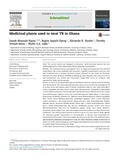Medicinal plants used to treat TB in Ghana

View/
Date
2015Author
Nguta, Joseph Mwanzia
Appiah-Oponga, Regina
Nyarko, Alexander K.
Yeboah-Manu, Dorothy
Addo, Phyllis GA
Language
enMetadata
Show full item recordAbstract
The current study was designed to document medicinal plant species that are traditionally used to treat tuberculosis (TB) by Ghanaian communities.
Methods
The medicinal plants used against TB or its signs and symptoms were selected using library and online published data searches. A guided questionnaire interview was also conducted with a botanist involved in plant collection at the Centre for Scientific Research into Plant Medicine (CSRPM) at Mampong. Data obtained were entered in Excel and summarized into means and frequencies using SPSS 12.0.1 for windows, and expressed as tables and bar graphs.
Results
A total of 15 medicinal plant species distributed between 13 genera and 13 families were documented. The following medicinal plant species were found to be used against TB in Greater Accra and Eastern parts of Ghana: Azadirachta indica A. Juss. Stem bark (Meliaceae), Hygrophila auriculata Heine, whole plant (Acanthaceae), Chenopodium ambrosioides L. leaves (Amaranthaceae), Coix lacryma-jobi L. glumes (Poaceae), Solanum torvum Sw. unripe fruits (Solanaceae), Solanum torvum Sw. leaves (Solanaceae), Bidens pilosa L. whole plant (Asteraceae), Phyllanthus fraternus G.L. Webster leaves (Phyllanthaceae), Dissotis rotundifolia (Sm.) Triana, leaves (Melastomataceae), Cymbopogon giganteus Chiov. Leaves (Poaceae), Cyperus articulatus L. roots (Cyperaceae), Allium sativum L. bulb (Amaryllidaceae), Zingiber officinale Roscoe, rhizomes (Zingiberaceae), Allium cepa L. bulbs (Amaryllidaceae), Allium cepa L. leaves (Amaryllidaceae), Aloe vera var. barbadensis aqueous extract from leaves (Xanthorrhoeaceae), Aloe vera var. barbadensis organic extract from leaves (Xanthorrhoeaceae), Cocos nucifera Linn, water (Arecaceae) and Cocos nucifera Linn. Husk (Arecaceae).
Conclusions
The collected plant species could be a source of a new class of drugs against TB. Bioactivity guided fractionation is recommended to identify lead compounds for antimycobacterial activity. The current paper documents for the first time medicinal plant species used by Ghanaian communities to treat TB. These results are a basis for selection of plants for further pharmacological, toxicological and phytochemical studies in developing new plant-based antimycobacterial drugs.
URI
http://www.sciencedirect.com/science/article/pii/S2212553115000643http://hdl.handle.net/11295/85622
Citation
International Journal of Mycobacteriology Volume 4, Issue 2, June 2015, Pages 116–123Publisher
Elsevier
